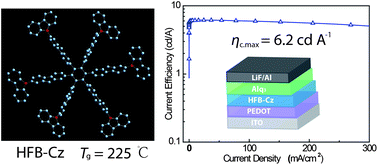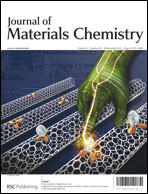Two new hole-transporting materials, namely HFB-Cz and HFB-Dpa, were designed and synthesized by attaching carbazole and diphenylamine units to the hexakis(9,9-dihexyl-9H-fluoren-2-yl)benzene (HFB) core via Buchwald–Hartwig coupling reaction. The long alkyl chain and core rigidity endow these compounds with good solution processability and high thermal stability. HFB-Cz and HFB-Dpa exhibit significantly high glass transition temperatures (225 and 154 °C) relative to widely used hole-transporting materials, such as N,N′-bis(3-methylphenyl)-1,1′-biphenyl-4, 4′-diamine (TPD, 65 °C) and 1,4-bis((1-naphthylphenyl)amino)biphenyl (NPB, 96 °C). Solution-processed green OLED devices using HFB-Cz and HFB-Dpa as hole-transporting materials exhibit very high efficiencies with a maximum current efficiency up to 6.2 cd A−1. These efficiencies are substantially higher than the NPB-based control device, and are among the highest for the hole-transporting materials in similar device configuration.
You have access to this article
 Please wait while we load your content...
Something went wrong. Try again?
Please wait while we load your content...
Something went wrong. Try again?


 Please wait while we load your content...
Please wait while we load your content...